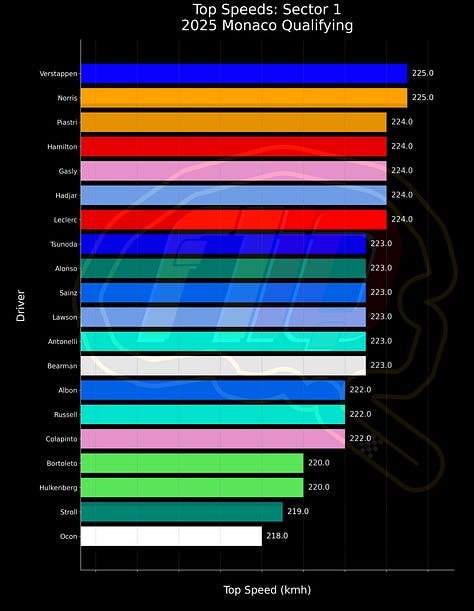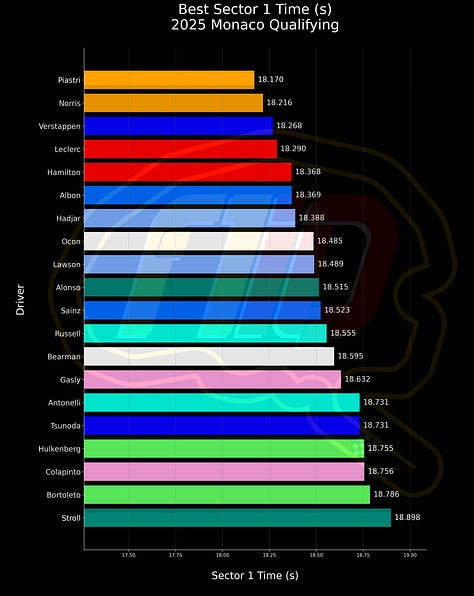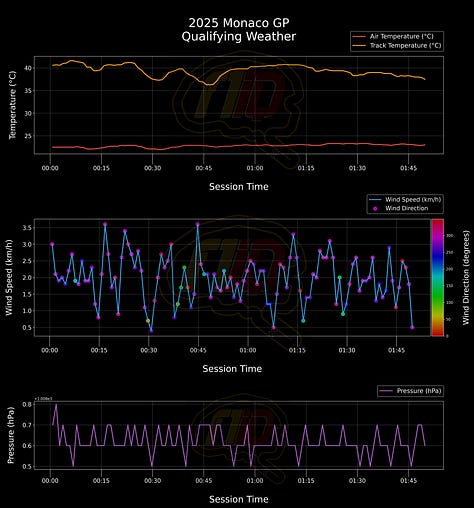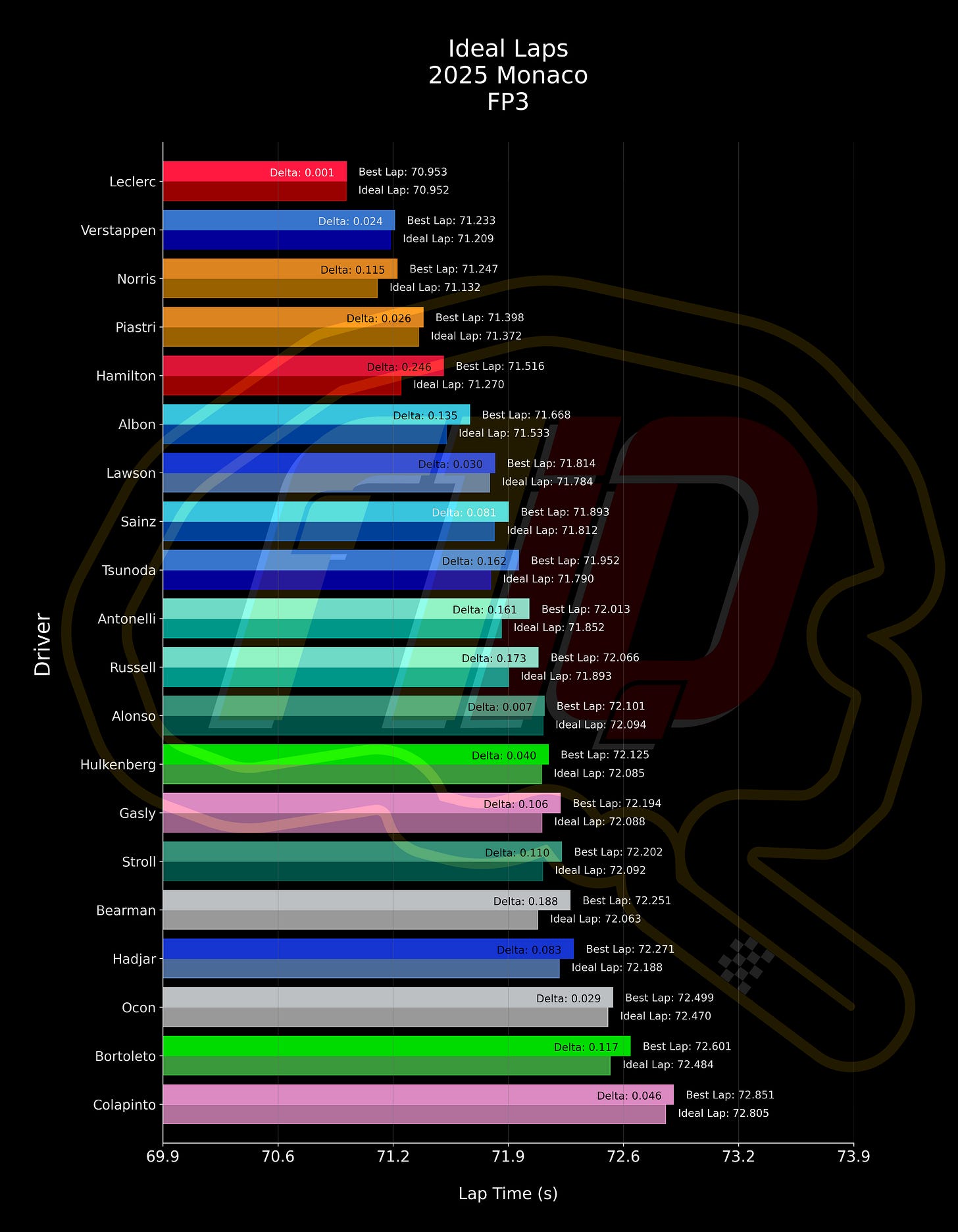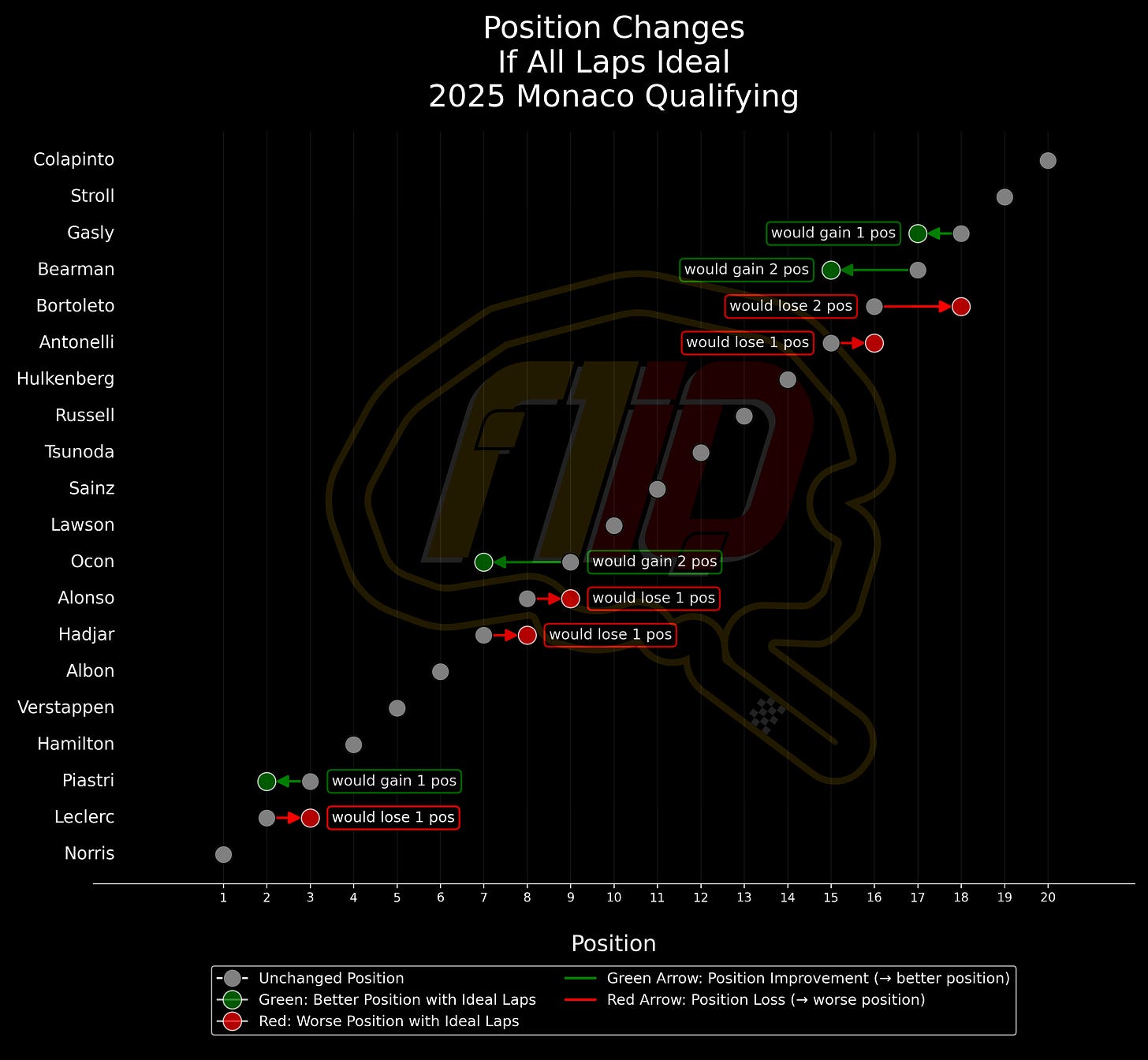Watching Formula One drivers driving at the limit to determine the grid order is always fascinating, and today was no different.
Before qualifying, however, there was the last practice session.
FP3
I imagine it is like opening for Led Zeppelin/Michael Jackson/Nirvana/Taylor Swift—choose according to your age, I guess—because you just KNOW you cannot do anything good enough to suppress the “when is this over so we can get to the good bit?” going through the crowd.
Third practice is the last chance to check you made the right changes after Friday and the direction is correct. Based on what we saw, that is not a sure thing for many teams.
Charles Leclerc continued to give the tifosi hope by leading the third practice, giving him 100% for the weekend so far. Although he did break the curse last season by finally winning the race, it is still doubtful that any of his fans are feeling secure about what will come on Sunday.
Thankfully, there were no serious accidents for most of the session, so the drivers had time to check everything before qualifying. Until, right before the end, Lewis Hamilton lost the car going into Mirabeau with just a couple of minutes to go and hit the wall quite hard with the right side of his Ferrari. Could be a bit of dirty air from having two cars ahead of him, could be a mistake while going for that last flying lap at full tilt, could be a combination of factors.
But he had to walk back, his Ferrari stricken on track with what the team will hope is light damage. And, for the tifosi and TeamLH’s sake, let the Scuderia mechanics check the car properly. They do have history on this track…
One interesting data point we learned in FP3 was about the tyres. Max Verstappen set an early fastest lap on the medium compound, jumping over the Ferraris and McLarens on softs.
At Monaco, the soft is the C6 and the medium is the C5—which is the soft in many other tracks—and the C6 is unproven and very lightly tested. This last point was made abundantly clear when drivers on the C6 could not top Verstappen’s C5 time, with only Leclerc managing it towards the end of the session.
Even Verstappen failed to beat his medium time when he switched to the soft tyres. The Pirelli allocation is heavier on soft tyres, as in most races, so teams were unlikely to have enough mediums to do all three phases of qualifying. But if the medium is better, when do you use yours?
The telemetry does not really solve the problem because Ferrari and Red Bull make their time in different ways, so it is challenging to read too much into it without a high degree of uncertainty.


If you are driving for one of the top teams, do you save for Q3, since you expect to get there, so you have the best chance at a good starting position? Or do you pull it out in Q2 to avoid an unpleasant surprise and then do whatever you can in Q3 with the soft?
If you are towards the back, do you put the medium on for Q1 and roll the dice, hoping for a vault into Q2 and then everything is gravy?
Or, even more difficult, do you save your mediums for the race, do pitstop after one or two laps and then deploy the mediums you saved to try to undercut drivers who do not stop early in the race?
It will be a fascinating strategy battle, thanks to the mandatory 2-stop rule. Do I still think it is stupid? Yes. But since it is here, we can only hope it brings something interesting to the table.
Drivers’ Championship leader Oscar Piastri had a tough session, staying closer to P10 than to the top for most of it, before finding a lap towards the end to claim the spot right behind Lando Norris. Pressure was on him to not do the same in qualifying, or else he could see his title rivals take a slice of his lead on Sunday.
Mercedes wwereleft scratching their heads after FP3, Kimi Andrea Antonelli P10 and George Russell P11. The team had to find something before qualifying or else they would be stuck in a very uncomfortable place on Sunday.
All drivers left at least a little time on the track, and the Mercedes’ drivers were no exception.
Neither driver hit their ideal laps, but even if they had done so, it would not have changed anything, as we can see by the Position Change If Ideal Lap graphic. Not what the team would have wanted to see going into the most important session of the weekend.
Although we can guess that, if someone were to ask the team if they would be fine with their FP3 results instead of what happened in qualifying, it is difficult to believe they would not agree without a second thought.
Since Mercedes vacated a couple of spots at the front, there were opportunities for some midfield teams, and Williams took their chance with both hands (and both drivers). Liam Lawson put his MinardiRossoTauri in the Top 10 as well, his teammate Isack Hadjar managing a clean session after his torrid FP2 but not finding time to match Lawson.
The South American contingent of Gabriel Bortoleto and Franco Colapinto, on the other hand, could not find their way out of the last two positions, Alpine’s Argentinian driver failing to avoid being dead last yet again. Not that Pierre Gasly found a lot of pace in his Alpine either, but at least he was in the thick of the mid-to-back battle. With Colapinto having a set expiration date, multiple sessions as the slowest driver in the field is not what he needs.
After almost 60 minutes of on-track action, FP3 ended under the red flag for Hamilton’s crash, and the teams retreated to their caves to figure out their qualifying plans.
In the interval, Formula 2 served up a strange race, with multiple accidents and lunges, but without destroying anything in the process, so the main event could happen without a hitch.
The next time F1 cars entered the track, every driver’s Sunday fate would be on the line.





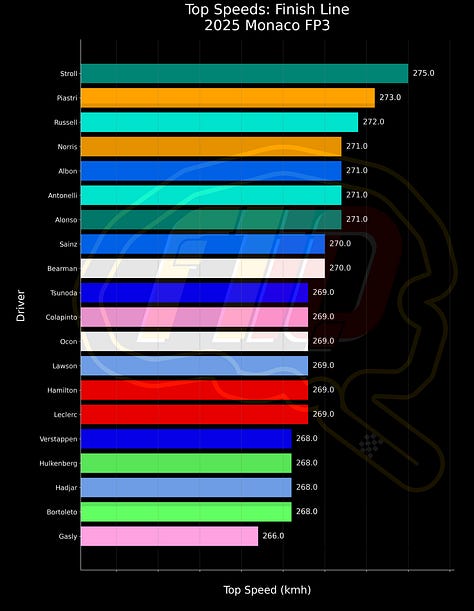




Qualifying
As I wrote yesterday, it is the most stressful qualifying session of the year for the drivers and the most glorious one for the fans. Almost everything hinges on the Saturday results, barring a rainy Sunday (or whatever the mandatory 2-stop rule will create).
No room for error, no possibility of taking it easy, and the tiniest mistake can become catastrophic. What’s not to like??
And, speaking of catastrophic, what other word can we use for whatever the hell qualifying session was for Mercedes? Antonelli made Q2 but did so while wrecking his car at the end of Q1. Russell made Q2 easily and then his car died at the top of the hill, coasting until the tunnel without power. The Mercedes driver tried to ctrl+alt+del the car, but the battery was dead. As were the team’s hopes for qualifying. They will line up P14 and 15 tomorrow, and without chaos happens, they are unlikely to have a good time.
Russell’s problems got in the way for Williams and Ferrari’s strategy of going with the medium for Q2. All four drivers had the yellow-walled rubber on—as did Russell, by the way—but when the session resumed, everyone was on the soft tyre. Crucially for McLaren and Red Bull, Ferrari used one of their sets, so we could see a strategic advantage for the former tomorrow.
Alpine tried the medium compound strategy in Q1 and it failed gloriously. Neither car made Q2 and, while they were on medium tyres, they were holding the last positions. Gasly was then treated to the Stroll Monaco Door Shutting Special, but his dance card did not include a crash.
Stroll, for his solid work, received a 3-place grid drop, which is added to the 1-place he already had from Friday. All that he needs is to do something tomorrow to get a 10-place to get a free ice-cream cone at the nearest shop.
When the session ended, Gasly and Colapinto were out, the Argentinian dead last yet again. Bortoleto could not drag his Sauber out of Q1, finishing in P16, while Oliver Bearman did not try too hard and did the 17th best time and Stroll in P19.
Important to remember that Bearman has a 10-place grid penalty, so he was always going to be at the back anyway, considering what the car’s pace allows him to do—although his teammate would show the car to be quite capable a bit later.
Aston Martin went the other way and, when Q2 resumed following the interruption for Russell’s issue, Alonso was on the mediums. He set the 7th best lap and then told his engineer that there was nothing more he could extract. The question then was whether it would be enough to make Q3.
There was a nice fight between Hadjar and Yuki Tsunoda, the former teammates and direct competitors for Lawson’s place, with Tsunoda holding 10th and moving on. Hadjar was in 11th and in danger of not making it to the last part of qualifying. Ultimately, Hadjar got the best of Tsunoda, jumping into the Top 10 while Tsunoda cannot improve and dropped into the elimination zone.
Williams lost Carlos Sainz in Q2, the Spanish driver complaining that the tyres were not working for him, leaving Alexander Albon to contest the last part of qualifying as the only Williams in the field.
Q3
Ferrari, McLaren, and MinardiRossoTauri all took two cars into Q3, Verstappen and Albon saw their teammates fall in Q2, while Esteban Ocon and Alonso squeaked through Q3 while their teammates did not even make Q2. Although, in Bearman’s case, it would be taking a risk with no likely reward, considering his penalty.
Crucially for Q3, however, Albon finished Q2 in P3. The Williams car is clearly not only a low-downforce, let’s go fast car. It works in most, if not all, conditions, and Albon would like nothing better than to mix with the leading cars. So he might spoil someone’s party if he could replicate that pace.
And then, finally, it was time for Q3 at Monaco. No more talking, no more if nor buts. Time to show what you got.
Albon was the first one out, with Ocon and Alonso following. And, surprise, surprise, Ocon and Albon were on mediums, while Alonso had used softs. The McLaren came out next with new softs, the same for Leclerc, who slotted behind his teammate, who was trailing Norris. However, Hamilton used one extra set, so he had to go with a used set for the first run. Lawson and Hadjar did the same and Verstappen was the last to leave the pits, with a shiny set of soft tyres, leaving it so late that he came out after Hamilton had already started his first flying lap.
Norris set the best lap, Piastri failed to beat him. Hamilton’s used set saw him half a second behind, and Leclerc could not get past the McLaren. And then came Verstappen, later than everyone, but only able to beat Hamilton’s used set lap.
Ocon managed best of the rest, in 6th place, until Albon went again and supplanted him, so both new medium sets beat the used softs of the other midfield challengers. Would they hold once everyone had new softs on? Unlikely, but Albon and Ocon were in a great position if it did happen.
The McLarens came out early for their second runs, and on their outlaps they had the track to themselves once Albon pitted for his second set of tyres. Both of them had new soft tyres, and Piastri was again ahead of Norris.
Ocon was the next to come out, with new soft tyres, and he was the only one ahead of the McLarens as they started their second runs.
Norris trumped Piastri in the first sector by 0.007, then Piastri had the best 2nd sector by over 0.1, so Norris had to find time in the last sector and Piastri only had to carry on his form to be fastest. It was not meant to be. Norris took advantage of Piastri’s yellow sector 3—meaning it was not even a personal best—to claim the best time and provisional pole position, both drivers with laps in the 10:1s.
Then, it was time to see what the others could do and, crucially, both McLaren drivers had time to go again.
Hamilton could not beat them, but Leclerc managed a purple sector 2—meaning it was the best overall in the session—and he crossed the line with the fastest lap time, the crowd roaring in delight.
Verstappen harried his Red Bull around the track but could not beat the Top 4, so it was 5th place for the defending champion. Not bad, considering his car’s pace, but also not good in a place where it is almost impossible to overtake.
Piastri was the first McLaren to come through, but he had a bad sector 2 and could not improve past 3rd place.
That left Norris as the only one who could beat Leclerc.
And the McLaren driver did it in style. He did the first-ever lap under 70 seconds around Monaco, to the delight of his team. The crowd, on the other hand, could be heard sighing in exasperation.


If anyone ever thoroughly earned a pole in Monaco, Norris certainly did. Leclerc and Hamilton both hit their ideal laps on their final attempts, but it was not enough to vanquish the McLarens.
If Piastri had hit his ideal, he would have made it a McLaren 1-2, but he would still not beat Norris, but he would also be under 70 seconds. But, alas, the honour of being the first one to do so is Norris’.
Behind them, the threat of Albon was overstated, and the Williams driver could only muster the 10th best time when everyone was on the soft tyres.
Hadjar—the driver with the two crashes in FP2, who called himself stupid for doing it, who was passed over for the Red Bull promotion—dragged his MinardiRossoTauri to P6. His time just a quarter of a second slower than Verstappen, a magnificent result for the rookie. He would start next to Verstappen, 5th and 6th for them, but Hamilton was given a 3-place grid penalty after the session, for impeding Verstappen, and that means they both jump one place up.
Hamilton went to Verstappen immediately after the session to explain that the team had told him the Red Bull was on a cool-down lap, and the defending champion appeared to be fine with it. The Stewards, however, were not.
Alonso, Ocon, and Lawson complete the grid, the Aston Martin driver losing out to Hadjar by 0.001, which must hurt. And then you remember that Alonso’s 1st Monaco GP was over three years before Hadjar was born, and coherent thought becomes impossible.
The order is set, the strategies will be updated and refined, and tomorrow the drivers have to pit twice and go around the Monaco rollercoaster almost 80 times.
I, for one, cannot wait.
